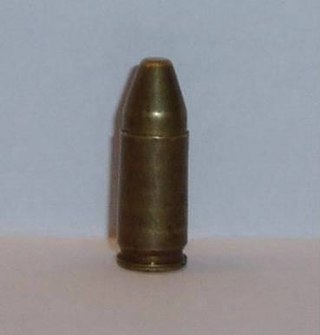
A machine pistol is an autoloading pistol capable of fully automatic fire, including stockless handgun-style submachine guns.

A submachine gun (SMG) is a magazine-fed automatic carbine designed to fire handgun cartridges. The term "submachine gun" was coined by John T. Thompson, the inventor of the Thompson submachine gun, to describe its design concept as an automatic firearm with notably less firepower than a machine gun. As a machine gun must fire rifle cartridges to be classified as such, submachine guns are not considered machine guns.

In firearms terminology, an action is the functional mechanism of a breech-loading firearm that handles the ammunition cartridges, or the method by which that mechanism works. Actions are technically not present on muzzleloaders, as all those are single-shot firearms with a closed off breech with the powder and projectile manually loaded from the muzzle. Instead, the muzzleloader ignition mechanism is referred to as the lock.

The Mauser C96 is a semi-automatic pistol that was originally produced by German arms manufacturer Mauser from 1896 to 1937. Unlicensed copies of the gun were also manufactured in Spain and China in the first half of the 20th century.

A semi-automatic pistol is a handgun that automatically ejects and loads cartridges in its chamber after every shot fired. Only one round of ammunition is fired each time the trigger is pulled, as the pistol's fire control group disconnects the trigger mechanism from the firing pin/striker until the trigger has been released and reset.
Blowback is a system of operation for self-loading firearms that obtains energy from the motion of the cartridge case as it is pushed to the rear by expanding gas created by the ignition of the propellant charge.

The MP 18 is a German submachine gun designed and manufactured by Bergmann Waffenfabrik. Introduced into service in 1918 by the German Army during World War I, the MP 18 was intended for use by the Sturmtruppen, assault groups specialized in trench combat, as a short-range offensive weapon that would provide individual soldiers with increased firepower over a pistol.

Rotating bolt is a method of locking the breech of a firearm closed for firing. Johann Nicolaus von Dreyse developed the first rotating bolt firearm, the "Dreyse needle gun", in 1836. The Dreyse locked using the bolt handle rather than lugs on the bolt head like the Mauser M 98 or M16. The first rotating bolt rifle with two lugs on the bolt head was the Lebel Model 1886 rifle. The concept has been implemented on most firearms chambered for high-powered cartridges since the 20th century.

The Moschetto Automatico Revelli-Beretta Mod. 1915 was a self-loading carbine that entered service in 1918 with the Italian armed forces. Designed as a semi-automatic carbine, the weapon came with an overhead inserted magazine, an unconventional design based on the simplicity of allowing a spent round to be replaced using assistance from gravity. The gun was made from half of a Villar-Perosa aircraft submachine gun.
The MAB 38, Modello 38, or Model 38 and its variants were a series of official submachine guns of the Royal Italian Army introduced in 1938 and used during World War II. The Beretta Modello 38 was first issued to Italian police units stationed in Africa. The Italian army were impressed and decided to adopt a version to be used by elite troops and military police, but requested a modified variant which had no bayonet and a different recoil compensator. The MAB 38 was widely used and saw service on all fronts. The guns were also used by the German, Romanian, and Argentine armies of the time.

The Pistola Mitragliatrice Fiat Mod. 1915, commonly nicknamed the Villar Perosa, was an Italian portable automatic weapon developed during World War I by the Officine di Villar Perosa.

The Mendoza RM2 was a light machine gun similar to the M1918 BAR manufactured in Mexico by Productos Mendoza, S.A. Rafael Mendoza have been producing machine guns for the Mexican Army since 1933 and all have been noted for their lightness, simplicity, ease of maintenance, and economic construction without sacrificing reliability.

The 9×25mm Mauser is a cartridge developed for the Mauser C96 service pistol around 1904 by DWM. Mauser pistols in this relatively powerful caliber were primarily intended for export to Africa, Asia, and South America. The 9mm Mauser Export cartridge was produced specifically for Mauser pistols and carbines made from 1904 to 1914 and then later from approximately 1930 to 1945 for submachine guns chambered for this caliber.

The Glisenti Model 1910 was a 9 mm calibre semi-automatic service pistol produced by the Italian company Società Siderurgica Glisenti. It was put in production in 1910 to replace the aging Bodeo Model 1889. It saw extensive service in World War I and World War II with the Royal Italian Army. The Model 1910 has a complex and weak firing system which mandates that the pistol ought to use weaker cartridges than pistols of comparable calibre.

The 9mm Glisenti is an Italian pistol and submachine gun cartridge.

The M49 submachine gun is a Yugoslavian submachine gun chambered in 7.62×25mm Tokarev, designed for use with the Yugoslav People's Army. While externally similar to the PPSh-41, as well as being able to interchange magazines, the M49 is actually very different in both construction and design. More similar in nature to the Italian Beretta Model 38, the M49 features a one-piece tube receiver which contains the bolt, recoil spring and buffer mechanism. Constructed of machined parts as well as simple tubing, the receiver assembly incorporates a ventilated barrel shroud to protect the operator from being burned during periods of rapid-fire, as well as a simple muzzle brake to steady the weapon.
The Armaguerra OG-43 and its subsequent version, OG-44, were submachine guns manufactured in small numbers in the Republic of Salo.














